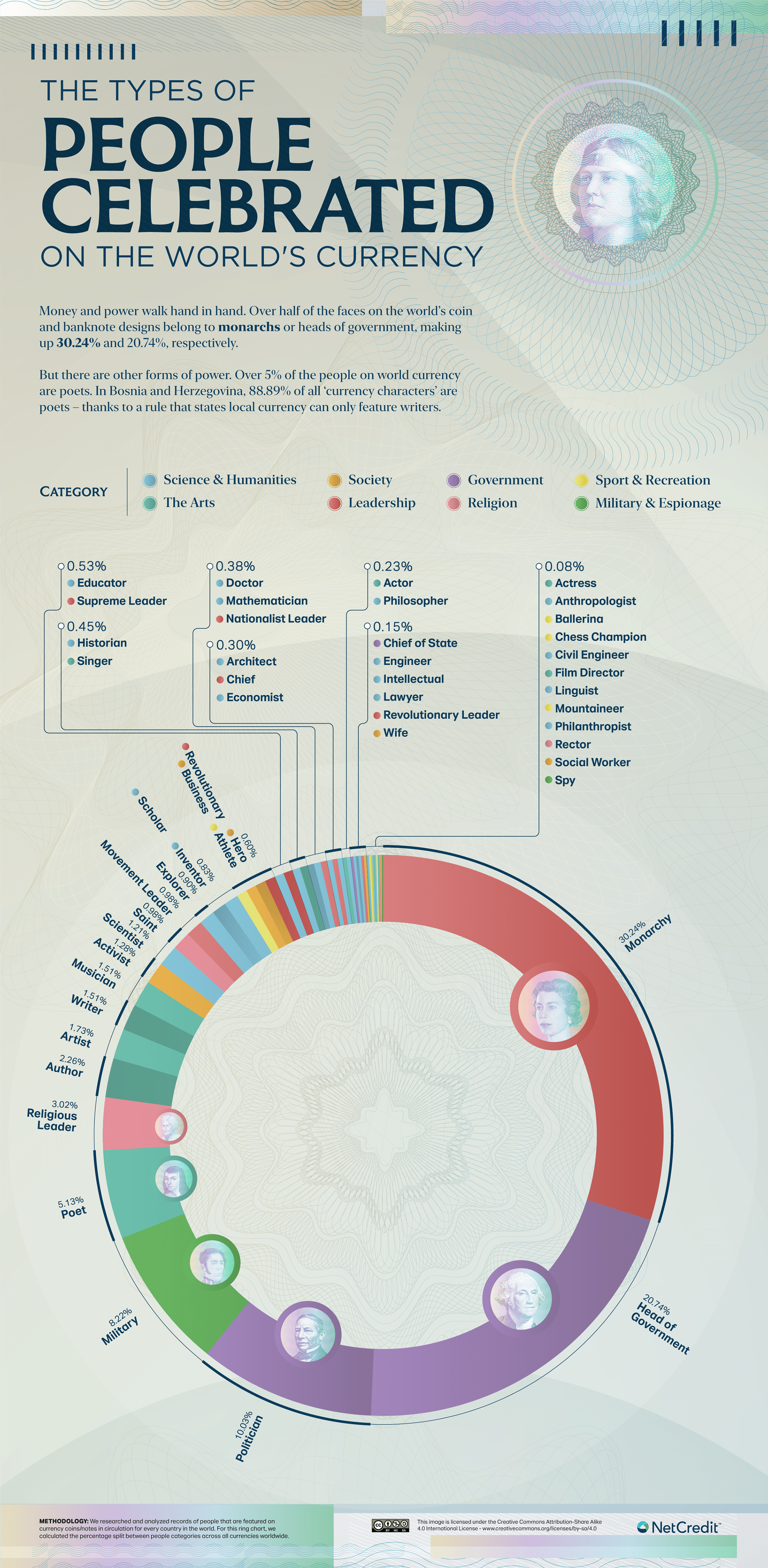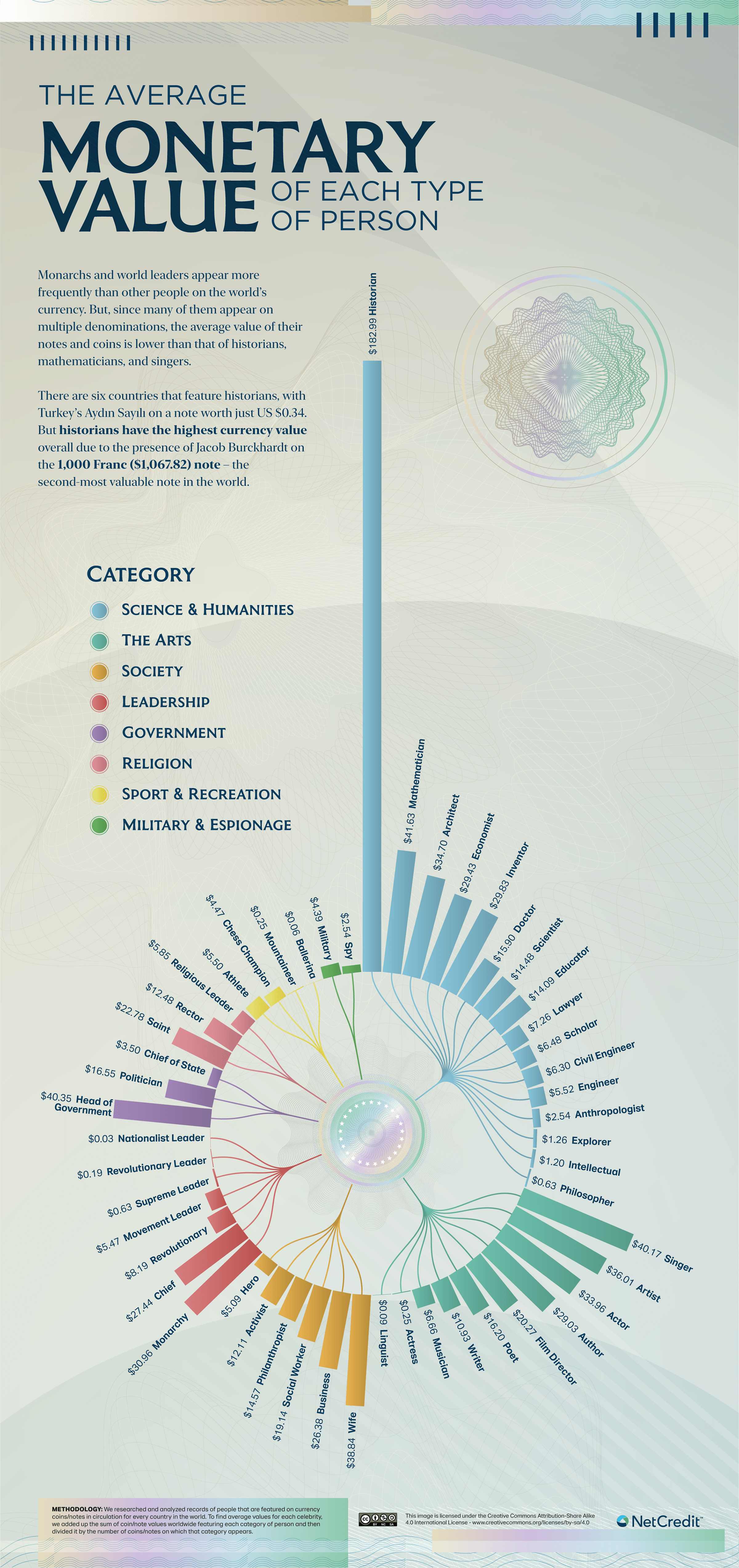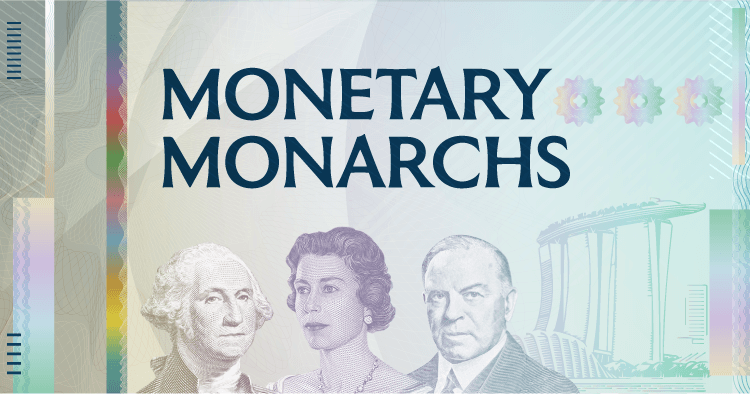Whose face would you put on a new dollar bill if the decision was yours? Maybe… your own?
It sounds vain, but that’s just what Spencer Clark, Superintendent of the U.S. National Currency Bureau, did in 1864. Instructed to put “Clark” on the new 5¢ note, he ‘misinterpreted’ the instruction and printed his own face rather than that of explorer William “Lewis and Clark” Clark.
Already a controversial figure, Spencer Clark’s moment of vanity triggered Congressman Russell Thayer to ban the appearance of living celebrities on U.S. currency – or, in his own words, “off with their heads!” To make sure of it, congress also banned the issue of banknotes under the value of 10¢. (These low-value notes were introduced because folk kept melting down nickels and dimes for the metal.)
A country’s banknotes and coins are almost a personality test for the country itself. At NetCredit, we’re passionate about cash as a cultural artifact, and not just a tool for living. So, we’ve counted the faces on the world’s currencies to find the types of people each country chooses to represent on money – and even how much each celebrity type is worth.
What We Did
We built a list of all coins and notes currently in circulation around the world, using only currencies from countries that feature a person on the obverse or reverse side. We researched the people on each banknote and assigned them an “honor” category (e.g., artist, monarch, politician) based on their role in society.
To calculate the average value of honors across the world, we converted all currency into dollars and averaged the value of each currency for each honor.
Key Findings
- Over half of the faces on the world’s coin and banknote designs belong to monarchs or heads of government, making up 89% and 20.83% respectively.
- Over 5% of the people on world currency are poets. In Bosnia and Herzegovina, 88.89% of all ‘currency characters’ are poets – thanks to a rule that states local currency can only feature writers.
- Queen Elizabeth II appears on one side of every piece of currency in England, Wales, and Australia, and on all Canadian coins – so ‘monarchs’ account for nearly half of the faces on those countries’ currency.
- Historians have the highest currency value overall due to the presence of Jacob Burckhardt on the 1,000 Franc ($1,067.82) note – the second-most valuable note in the world.
Famous Faces: Around the World In Every Currency
Start by playing with this interactive tool to rank the countries by how many of each profession they have on their cash. And then scroll on for the rest of our money nerd charts and graphs.
Queen Elizabeth II Leads Monarchs to Front of One-Third of World’s Currency
Monarchs are the clear favorite choice for currency celebrities – and Queen Elizabeth II is the clear favorite monarch. Top royals appear on 29.86% of all currency that features people, according to our analysis.
English currency has starred a living monarch since Henry VII’s gold sovereign in 1489. Before then, only generic king and queen illustrations were featured. Today, Queen Elizabeth holds the world record for ‘most currencies featuring the same individual’ – including Australia, Bermuda and Canada.

Click here to see this image in full size
There aren’t many places where you’ll see military figures (8.23%) and poets (5.13%) shoulder to shoulder, but these are the fourth and fifth most common types of people to appear on national currency. In fact, the wordsmiths are giving the generals more than a ‘run for their money’ – when you combine poets with authors (2.26%) and other writers (1.51.%), the scribes overtake the militants with a combined share of 8.91%.
U.S. Currency Among Most Diverse of Major Countries
The U.S. has among the most diverse sets of currency figures. While two-fifths of U.S. currency features a politician and another two-fifths features presidents, 12 other celebrity types make up the remainder. These include a mountaineer (John Muir), a poet (Maya Angelou) and a native American explorer (Sacagawea – Shoshone interpreter for the William Clark) on the dollar.

Click here to see this image in full size
There is a definite military bias on Venezuelan currency, which has become so devalued that some notes are worth more as a crafts material. But in Norway, the humanities have their day: writers, artists, singers and authors occupy a combined 57.16% of currency, with King Harald V on 28.57%. Non-human celebrities on the Norwegian krone include Ulvær Lighthouse, a Viking ship and a cod. Sadly, Norway’s Conservative party has pledged to discontinue paper money by 2030.
Average Ballerina-themed Currency Outvalues that Featuring Nationalist Leaders
It’s a world where mathematicians are worth more than monarchs. The latter is spread over such a variety of currencies that their value is dragged down to a mediocre $31.21, while mathematicians feature only on paper currency, worth an average of $41.02.
But historians take home the bacon. Appearing on just 0.45% of the world’s peopled currency – and no small coins – historians rack up an average of $176.56 across Peru, Switzerland, Tajikistan, Tunisia, Turkey and Ukraine. The clue is Switzerland: historian Jacob Burckhardt features on the 1000-franc ($1068) note of this wealthy country.

Click here to see this image in full size
Spare a thought for the philosophers, though. They still can’t make a buck. Philosophers feature on the currency of just three countries: Nicaragua, Tajikistan and Venezuela, on notes to a value of $0.63. Nicaragua’s green C$10 note features the philosopher, lawyer and poet Miguel Larreynaga, a “hero of Central American independence” who was among the party sent to Spain to negotiate for independence.
A Place in History You Can’t Buy
The Spencer Clark 5¢ remained in print until 1866, and Clark eventually resigned over book-keeping issues in 1868. But his face remains better known than that of the average civil servant because it achieved that rare honor of gracing a national banknote.
Becoming a currency celebrity is one of the surest ways of staying in the public eye. Notes and coins occupy pockets and are handled daily; discontinued, they become collector’s items for decades or centuries. A coin is more durable than a history book, and a meaningful banknote will be illustrated in multiple history books. Which tech moguls, social media influencers and reality TV stars do you think will get the dollar bill treatment in years to come?
METHODOLOGY AND SOURCES
First, we built a list of all coins and notes currently in circulation around the world, using only currencies from countries that feature a person on the obverse or reverse side.
We built them using these Wikipedia lists: people on banknotes and people on coins. We excluded countries with only one coin or note that featured a person.
We then researched the people on each banknote and assigned them an “honor” category (e.g., artist, monarch, politician) based on their role in society, allowing us to calculate the split of honors within each country’s currency.
To calculate the average value of honors across the world, we converted all currency into dollars and averaged the value of each currency for each honor.
The data was gathered in March 2022.
DISCLAIMER: This content is for informational purposes only and should not be considered financial, investment, tax or legal advice.






